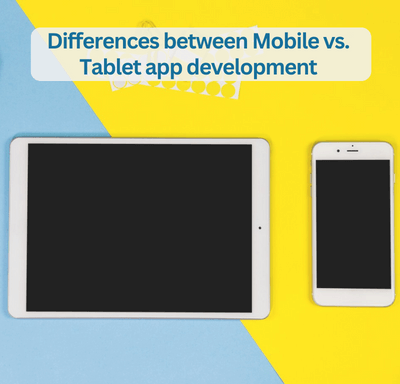
About us
Our Services
Our Expertise
Our Experience
Follow us
Why e2logy?
- We strive to provide superior customer service and ensure that every client is completely satisfied with our work.
- Our engineers are trustworthy, dedicated, and experienced and will go the extra mile to solve your IT issues.
- We are committed to delivering outstanding, cutting-edge IT solutions that add real value that goes beyond what is expected.

Differences between Mobile vs. Tablet app development

Smartphones and tablets have become an essential part of everyday life in our digital age. As a result of these devices, staying connected, communicating with others, and accessing information has become a part of our daily routine.
Mobile app development is becoming increasingly popular as a means of engaging customers and reaching new markets. Developing apps comes with a crucial decision. Would it be better to focus on developing mobile apps or tablet apps?
Learn which app development option is most suitable for your business by comparing phone apps and tablet apps in this article. You will also learn about E2logy, a leading platform for app development, which can streamline your organization’s app development process.
Differences between Mobile vs. Tablet app development
Compared to tablet apps, mobile apps have many differences. An app that delivers a powerful user experience must understand what mobile and tablet users want.
Utilization of devices
Users spend different amounts of time on mobile devices and tablets. This is one of the most significant differences between the two. It is common for users to glance at mobile devices for only a short while and then put them down. As a result, tablets tend to be used for longer periods during single sessions because they are often used for different purposes. In comparison to tablets, mobile sessions last half the time as tablets.
A tablet app is worth implementing if your enterprise analyzes and communicates data and your users will spend considerable time exploring it.
Sizes of screens
Screen size and resolution are two key differences between mobile apps for smartphones and those for tablets. Since smartphones generally have smaller screens than tablets, mobile applications running on tablets may not have the same crisp, clear resolution as tablet applications running on tablets. The solution to this issue requires mobile application developers or mobile application development firms to create two applications.
Mobile applications can be tailored to fit the smaller screen size of a smartphone with a lower screen resolution and those tailored to fit the higher screen size and resolution of a tablet. Both applications will have similar features/functionalities (mostly) but they will look as clear and crisp on both tablets and smartphones.
User numbers
Due to their increased usage by multiple users, tablets are less personal and emotional engagement platforms. If your app has features that allow multiple users to log in or access sensitive information, keep this in mind when integrating them.
Making a difference with UI and UX
Various screen sizes are supported by Android OS. A flexible and adaptable User Interface (UI) with elements for different screens is important to consider when designing your project.
Having multiple sets of information available at once on a tablet is easier thanks to the extra space available. It is usually necessary to split and display an app separately on smartphones.
The user experience won’t be enhanced if the mobile app doesn’t properly resize to fit a tablet’s screen, even if the app resizes properly. Creating design layouts with different fragment combinations will be beneficial for better development: the “multi-pane” layout for tablets, and the “single-pane” layout for smartphones.
Location of use
To understand a user’s situation, it’s important to know what they are going through. A smartphone is more likely to be used while distracted and to be viewed as personal property than a tablet. As a result, mobile device usage is more likely to be discussed in social and emotional circumstances.
There are also differences in user demographics between tablets and smartphones. As far as age and expectations are concerned, mobile and tablet use differs significantly.
Navigation and the user interface
The user interface and navigation of phone apps differ greatly from those on tablets. As phones are designed to be used quickly, users should be able to access the full functionality of the app with one or two taps.
While tablets are designed with larger screens and more detailed information in mind, smartphones are designed with smaller screens. A richer user experience is possible through the use of multiple screens or sidebars to display features.
A cost-benefit analysis of development
In addition to the costs of developing apps for phones and tablets, it’s important to consider the time and resources needed to do so. The cost of developing phone apps may be higher since phones generally require more code and optimization than tablets.
Developers may also need to create a separate version of an app for specific devices since phones have a wide range of screen sizes and resolutions.
It is, fortunately, possible to streamline and make more efficient app development with the right platform. Development of mobile apps can be done quickly and cost-effectively with E2logy’s platform for building and managing mobile apps. A wide range of devices can be supported by its powerful tools to build engaging experiences.
Conclusion
There are many similarities between mobile apps and tablet apps, despite their differences. Operating systems are one example. Regardless of whether you work with iOS or Android, designing software for mobile or tablet platforms isn’t much different.
When developing an app for several operating systems, it is important to consider the market share and approval process of each platform. If you want to maximize your tablet or mobile application project, you must work with a professional app developer.













